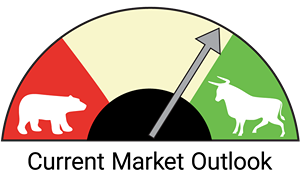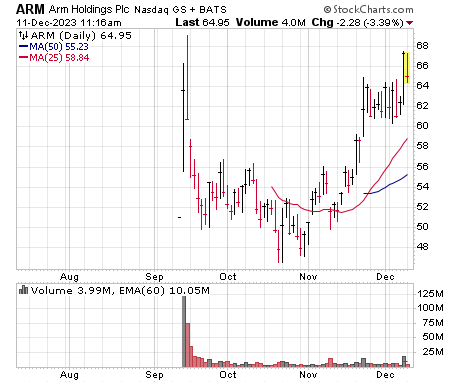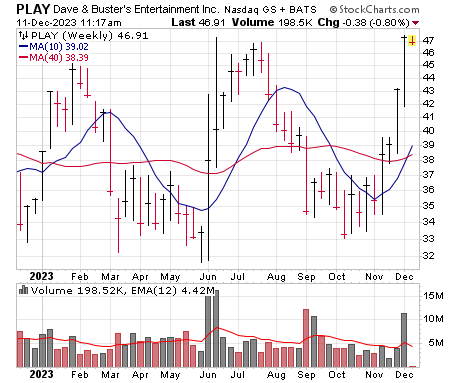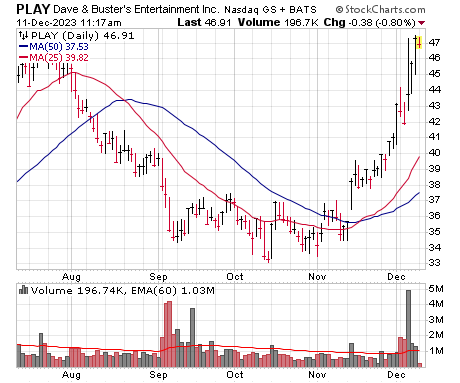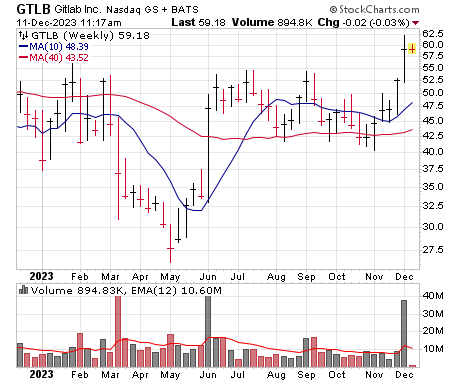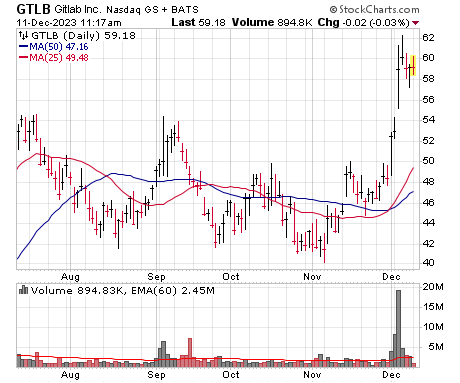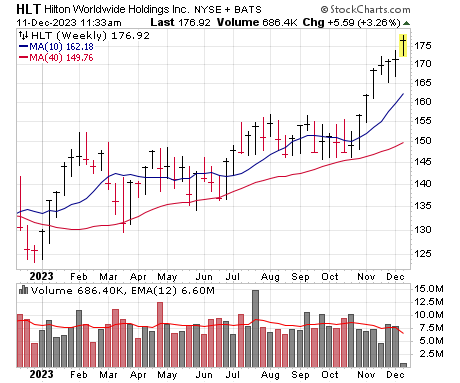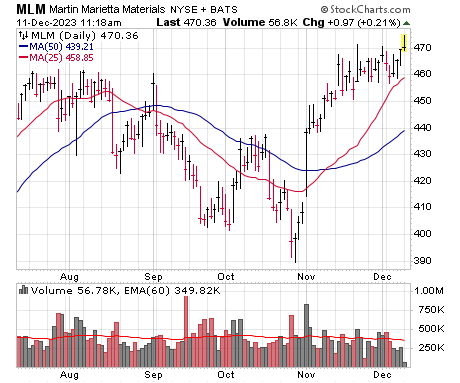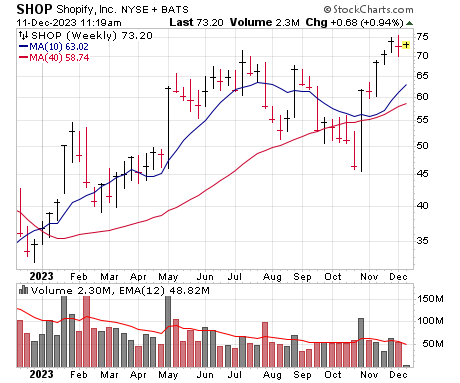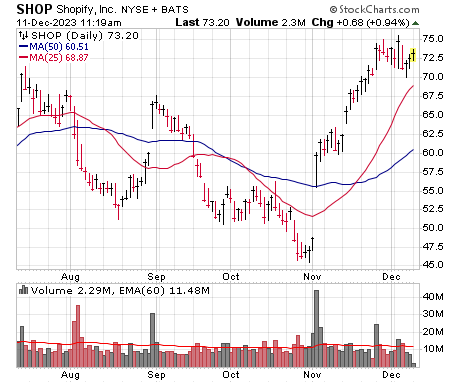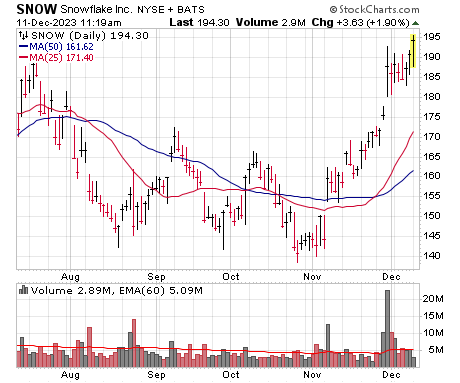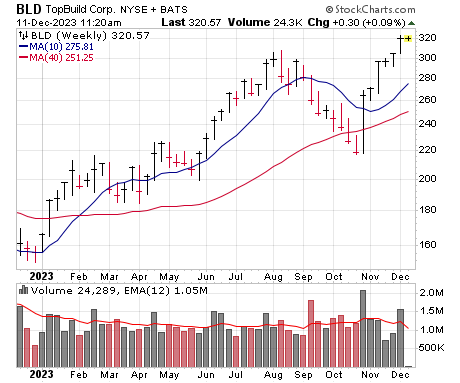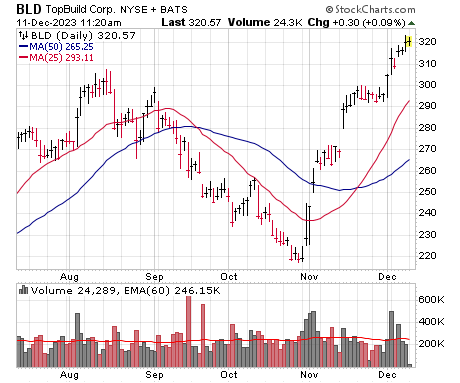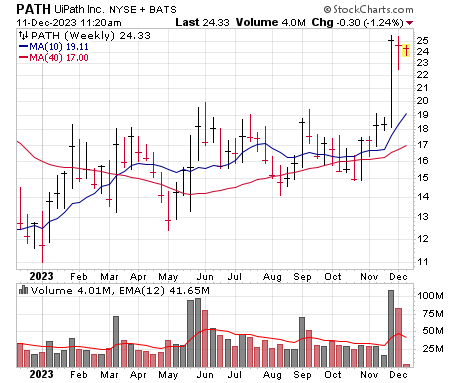Leaders Continue to Lead
We continue to see some near-term tremors, with rotation on a near-daily basis between different sectors and segments of the market, along with some signs of giddiness and a couple high-profile stocks taking on water; with the Fed meeting and inflation report this week, it’s possible some not-as-good-as-hoped news could cause some selling. Still, beyond that, the evidence looks pretty great, both from a top-down perspective (intermediate-term trends are up for the indexes and 80% of stocks) and, even more so, among leading stocks, which continue to behave themselves, with a lot of controlled pullbacks and tight action among those that have dipped—while many others are still pushing higher. All in all, we’re encouraged, though for the moment we do think it’s best to pick your spots and stocks more carefully as we see how the market handles this week’s events. Our Market Monitor stands at a level 7.
This week’s list has another balanced collection of ideas, with many different sectors and types of stocks. Our Top Pick is one of many turnaround-type retailers that’s perking up—Dave & Buster’s (PLAY) is cheap, has a new-ish management team, is buying back shares like mad and should see solid earnings growth ahead.
Price |
| Arm Holdings (ARM) |
| Dave & Buster’s (PLAY) ★ Top Pick ★ |
| GitLab (GTLB) |
| Hilton (HLT) |
| KKR (KKR) |
| Martin Marietta (MLM) |
| Shopify (SHOP) |
| Snowflake (SNOW) |
| TopBuild (BLD) |
| UiPath (PATH) |
Stock 1
Arm Holdings (ARM)
Price |
Why the Strength
ARM designs computer chip architecture and intellectual property around them that it sells to clients. The designs are used in nearly every mobile phone in the marketplace, making it one of the most important tech businesses around these days. In September, ARM went public in the largest IPO of the year, raising nearly $5 billion and valuing the business at $54 billion. In its first quarter as a public business, reported a month ago, ARM demonstrated the power of that market position: Revenue rose 28% to $806 million with earnings of 31 cents more than doubling from a year ago and easily topping estimates. Licensing sales doubled on the year, powered by 20% gains in cloud and automotive applications, to total $388 million. The larger royalty business saw revenue dip 5% in the period to $418 million, partly because ARM is still heavily reliant on global mobile phone volumes, which are struggling. The company is shifting to be increasingly based on payments from users in cloud and auto, which have higher royalty rates. That should push royalties up 5% this quarter, with double-digit growth rates to follow. What’s especially exciting about ARM is that the emergence of AI adds some demand volatility that is almost certainly going to benefit business to the upside, with management saying it is nearly daily that AI-driven demand projections are being raised. In practical terms, that means ARM’s clients want to make all sorts of end-user devices AI-capable, be they smartphones, smart speakers, laptops and so on. ARM says the current quarter’s sales will be unchanged to up 10% from a year ago, but investors should expect news of large agreements in the period that will feed future quarters. Consensus estimates see sales of $763 million and earnings per share of 25 cents for Q4.
Technical Analysis
ARM rallied to a high of 69 two days after its mid-September IPO, sunk to 50 within a few days and then spent nearly two months chopping between 47 (low in late October) and 56. The market’s improvement saw the stock lift back into the mid-60s in November, and after a tight consolidation, ARM lifted to new closing highs last week on great volume ... though today’s big-cap tech wobbles pulled the stock back in. It looks like a solid “U-Turn” IPO pattern overall, but we’ll set our buy range up from here, looking for a resumption of the breakout to enter.
| Market Cap | $68.9B | EPS $ Annual (Mar) | ||
| Forward P/E | 64 | FY 2022 | 0.65 | |
| Current P/E | 73 | FY 2023 | 0.64 | |
| Annual Revenue | $2.84B | FY 2024e | 1.06 | |
| Profit Margin | 47.1% | FY 2025e | 1.37 | |
| Qtrly Rev | Qtrly Rev Growth | Qtrly EPS | Qtrly EPS Growth | |
| ($M) | (vs. yr-ago-qtr) | ($) | (vs. yr-ago-qtr) | |
| Latest qtr | 806 | 28% | 0.37 | 118% |
| One qtr ago | 675 | -2% | 0.24 | 4% |
| Two qtrs ago | 633 | -4% | 0.12 | -27% |
| Three qtrs ago | 724 | 6% | 0.12 | -27% |
Weekly Chart | Daily Chart |
Stock 2
Dave & Buster’s (PLAY) ★ Top Pick ★
Price |
Why the Strength
We’ve seen a lot of turnaround-type retailers do well, mostly in the apparel field, but Dave & Buster’s is more of a restaurant/entertainment play that seems next in line to benefit from that trend. The company operates 159 namesake locations that are basically a mix of an arcade and a casual restaurant that appeals to older families and adults looking for a fun time; plus, thanks to a 2022 acquisition, it also has 58 Main Event locations that have a similar vibe but its customer base skews younger (families with children). It’s always been a differentiated business that’s very profitable (free cash flow is much larger than earnings; store-level EBITDA margins of 35%!), but growth has been stagnant (excluding the acquisition, revenue growth is flat this year), which is one reason there’s been a change at the top—the buyout of Main Event brought a new management team that was highly successful at expanding that operation while keeping costs in check, and it thinks it has many levers to accomplish the same thing with the new, larger company. Indeed, at a June Investor Day, the top brass indicated it expects to grow the store base by 16% over the next couple of years (and sees long-term potential of 550 locations), which, combined with efficiencies and organic growth, should help EBITDA to nearly double from 2022 to 2025—and sees cumulative free cash flow during the next five years of $1.7 billion (90% of the current market cap) even if all current locations don’t grow at all! Not surprisingly, then, management thinks the stock is a bargain and is buying back shares like mad, repurchasing 17.5% of the total in the first nine months of the current fiscal year. Analysts see revenue growth of 7% next year with earnings rising more than 20%. It’s an interesting story that looks cheap and, if business does rebound, could see the bottom line soar.
Technical Analysis
PLAY rebounded strongly after its pandemic crash, hitting 52 in March 2021, but it’s been rangebound ever since, hovering mostly between 30 and 50 as the stock bobbed and weaved with the market and was held back by stagnant growth; as recently as October, the stock was still in the low 30s. But the recent quarterly report and improved market environment may have caused a change in character, with shares building on their rebound to surge back near the top of the range. We’re OK starting a position here or on dips of a point or two, with the idea of adding shares on continued strength.
| Market Cap | $1.90B | EPS $ Annual (Jan) | ||
| Forward P/E | 11 | FY 2022 | 2.21 | |
| Current P/E | 16 | FY 2023 | 2.79 | |
| Annual Revenue | $2.17B | FY 2024e | 3.54 | |
| Profit Margin | 0.1% | FY 2025e | 4.28 | |
| Qtrly Rev | Qtrly Rev Growth | Qtrly EPS | Qtrly EPS Growth | |
| ($M) | (vs. yr-ago-qtr) | ($) | (vs. yr-ago-qtr) | |
| Latest qtr | 467 | -3% | 0.01 | -90% |
| One qtr ago | 542 | 16% | 0.60 | 2% |
| Two qtrs ago | 597 | 32% | 1.45 | 7% |
| Three qtrs ago | 564 | 64% | 0.80 | 54% |
Weekly Chart | Daily Chart |
Stock 3
GitLab (GTLB)
Price |
Why the Strength
GTLB’s story revolves around the fact that, these days, software basically runs the world, and many mid- to large-sized enterprises have big software development teams in-house to improve, tweak, patch and upgrade various codes (not to mention the many firms that are pushing out software to their clients). The problem comes with efficiently developing the software, testing it (for functionality and security) and then sending it out to users; right now, the vast majority of firms use at least two and sometimes up to 10 different systems to help them do all of this. GitLab has a better way, with a comprehensive platform that tons of clients are adopting because it boosts productivity and reduces software spend thanks to faster coding and planning, automated testing, and with improved security, too. Indeed, the company says customers are seeing cycle times that are seven times faster, while, for revenue-generating apps, the payback on the initial investment for its platform is under six months! It’s a behind-the-scenes offering for most of us, but the opportunity should be huge, with three-quarters of firms likely to consolidate to a single “DevSecOps” platform (industry jargon) from many point solutions within the next few years—and GitLab is the clear leader according to industry analysts. Already, more than 50% of the Fortune 100 are customers, and growth, while slowing, remains solid: In Q3, sales rose 32% while earnings of nine cents compared to estimates for breakeven, while many sub-metrics (874 clients with more than $100k of spend, up 37%) were also excellent. Analysts see the top line lifting 28% next year (likely conservative) while earnings continue to lift. It’s a good story.
Technical Analysis
GTLB effectively bottomed out for a year (spring 2022 to spring 2023) before gapping up nicely on its Q1 report in early June. But that led to another multi-month rest period as the stock was capped by resistance at 55. Now, finally, it looks like GTLB is starting to move—shares have risen six weeks in a row, capped by last week’s earnings-induced breakout, with the breakout day coming on nearly 10x average volume (usually a very good clue). We’re game for starting a position here with a stop in the low 50s, and aiming to average up if shares show further big buying.
| Market Cap | $9.22B | EPS $ Annual (Jan) | ||
| Forward P/E | 169 | FY 2022 | -0.66 | |
| Current P/E | 999 | FY 2023 | -0.46 | |
| Annual Revenue | $540M | FY 2024e | 0.13 | |
| Profit Margin | 9.7% | FY 2025e | 0.35 | |
| Qtrly Rev | Qtrly Rev Growth | Qtrly EPS | Qtrly EPS Growth | |
| ($M) | (vs. yr-ago-qtr) | ($) | (vs. yr-ago-qtr) | |
| Latest qtr | 150 | 32% | 0.09 | N/A |
| One qtr ago | 140 | 38% | 0.01 | N/A |
| Two qtrs ago | 127 | 45% | -0.06 | N/A |
| Three qtrs ago | 123 | 58% | -0.03 | N/A |
Weekly Chart | Daily Chart |
Stock 4
Hilton (HLT)
Price |
Why the Strength
All travel firms got whacked during the pandemic but have seen strong growth since—but the stocks have been mostly waterlogged as quarter after quarter of strong results have been met with investor expectations that the economy (in large part due to the Fed) would eventually keel over and bring lofty cash flow and earnings down to Earth. But now, with the Fed likely off the market’s back, perception is changing that these big figures may not go down—and will very likely go up in the quarters to come. Hilton needs no introduction, being one of the major hotel chains out there, and it’s positioned as the leader in the sector (stock-wise) as the numbers are solid, the firm remains in expansion mode and management is returning a good chunk of money to shareholders. In Q3, sales (up 13%) and earnings (up 27%) met or exceeded expectations while EBITDA lifted 14%, and there should be plenty more where that came from—Hilton added 14,300 net rooms to its ledger in the quarter (total room count up 4%; should be up 5% for the full year) and has a whopping 457,000 more rooms in the development pipeline (up 10% from a year ago), all while revenue per available room is booming (likely up 12%-plus this year) as prices rise and occupancy is tight. Moreover, there’s an active share buyback program in place, with the share count down 4.7% from a year ago and nearly 7% from two years ago, with the top brass recently reloading the buyback authorization. Analysts see revenue up just 7% next year, but earnings and cash flow should do better and many think these guesstimates will prove conservative as the action of many strong travel-related stocks suggests.
Technical Analysis
HLT’s post-pandemic rally stalled out in the 160 area over many months in late 2021 and early 2022 before the stock retreated 35% during the 2022 bear phase. The stock actually bottomed last June, but it never really let loose on the upside—as of a few weeks ago, shares were still below that prior high near 160, albeit trading extremely tightly (a sign the weak hands were out). Now we see the buying, with pristine action over the past few weeks that’s seen HLT break out and rally nicely, up seven weeks in a row coming into this week, and surging higher today. We’re OK nabbing some shares on dips.
| Market Cap | $45.5B | EPS $ Annual (Dec) | ||
| Forward P/E | 25 | FY 2021 | 2.08 | |
| Current P/E | 28 | FY 2022 | 4.89 | |
| Annual Revenue | $10.1B | FY 2023e | 6.09 | |
| Profit Margin | 16.4% | FY 2024e | 7.00 | |
| Qtrly Rev | Qtrly Rev Growth | Qtrly EPS | Qtrly EPS Growth | |
| ($B) | (vs. yr-ago-qtr) | ($) | (vs. yr-ago-qtr) | |
| Latest qtr | 2.67 | 13% | 1.67 | 27% |
| One qtr ago | 2.66 | 19% | 1.63 | 26% |
| Two qtrs ago | 2.29 | 33% | 1.24 | 75% |
| Three qtrs ago | 2.44 | 33% | 1.59 | 121% |
Weekly Chart | Daily Chart |
Stock 5
KKR (KKR)
Price |
Why the Strength
KKR is a Bull Market Stock, with a business that generally benefits if asset prices are on the rise, so with the market (both stocks and bonds) improving, investors are expecting results to improve in a big way. Not that things are terrible right now—KKR ended September with $528 billion of assets (mixed between private equity, which is by far the largest segment, as well as real estate, credit and insurance operations), though that was up just 6% from the year before as the markets were weak and fundraising was limited; like its peers, the firm has been emphasizing fee-based assets to smooth out results (not so reliant on one-time realizations from private equity), with that making up $424 billion of the total. In Q3, fee-related earnings (63 cents per share, up 3%) and distributable earnings (88 cents, down 7%) also mostly meandered. Still, the stock is strong today for two reasons, one of which we already mentioned—if the market rally can continue and money becomes less tight, it’s likely that inflows for KKR’s various funds should increase at a much faster clip, leading to both one-time and recurring revenue gains. The second reason is more company-specific: KKR recently bought the 37% of insurance outfit Global Atlantic it didn’t already own for $2.7 billion (all-cash deal), which investors see as accelerating asset growth and improving most metrics—indeed, the top brass sees a 10% boost to both fee-related and distributable earnings per share next year as a result of the deal, as well as a 20% boost to total operating earnings. Bottom line, business here is already solid and is set to improve in a big way, and if the market can continue its winning ways, the upside could be big.
Technical Analysis
KKR bottomed out last October with the market, but unlike some big-cap winners, it never really got going after that, making a few marginal recovery highs but then sinking back to 54 (below its 200-day line) as the market got whacked in October. But since the market bottomed, KKR has been a totally different stock, hitting new highs November 14 and then surging two weeks ago on the Global Atlantic buyout, with new highs in recent days. We’ll set our buy range down a bit, expecting a reasonable dip near term.
| Market Cap | $65.9B | EPS $ Annual (Dec) | ||
| Forward P/E | 16 | FY 2021 | 7.37 | |
| Current P/E | 39 | FY 2022 | -1.06 | |
| Annual Revenue | $12.6B | FY 2023e | 3.39 | |
| Profit Margin | 14.8% | FY 2024e | 4.89 | |
| Qtrly Rev | Qtrly Rev Growth | Qtrly EPS | Qtrly EPS Growth | |
| ($B) | (vs. yr-ago-qtr) | ($) | (vs. yr-ago-qtr) | |
| Latest qtr | 3.32 | 79% | 0.53 | N/A |
| One qtr ago | 3.63 | 999% | 0.94 | N/A |
| Two qtrs ago | 3.13 | 213% | 0.36 | N/A |
| Three qtrs ago | 2.53 | -38% | 0.09 | -89% |
Weekly Chart | Daily Chart |
Stock 6
Martin Marietta (MLM)
Price |
Why the Strength
The U.S. non-residential construction boom continues, with the latest numbers showing 17 months of non-stop growth that’s pushing prices for construction aggregates like sand and gravel to multi-decade highs. The trend is proving to be a windfall for Martin Marietta (covered in the November 6 issue), as the firm is a top provider of aggregates and downstream products such as mixed concrete and asphalt, as well as paving services for both the private and public sectors. Pricing momentum contributed to solid revenue growth in Q3 while setting all-time quarterly records across a number of product categories, with much of the strength focused in the red-hot Southeastern U.S. construction market. The sanguine results prompted Martin Marietta to raise production guidance for the coming year, affirming that “increased federal and state level investments and heavy industrial projects of scale” around the country should counter-balance slowdowns in private residential construction. Looking ahead, Martin Marietta intends to concentrate on what it sees as accelerating demand for “quality” aggregates; to that end, the firm just divested its South Texas cement business and other concrete operations—a move the company said will boost balance sheet flexibility and shareholder value. The company also sees an opportunity in “structurally underbuilt” U.S. single-family housing and believes loosening (or not as tight) credit conditions in 2024 could kickstart a boom in this space, and, big picture, continued demographic growth in the Southeastern states could lead to aggregates strength moving forward. It’s not an explosive growth story, of course, but Martin Marietta should crank out solid double-digit EBITDA growth for many quarters—with upside should the economy accelerate with the Fed off its back.
Technical Analysis
MLM dropped steadily for almost three months from its August high around 460, shedding 16% in the process. But the exhale got rid of all the weak hands and (especially after a sharp late-October shakeout to new correction lows) paved the way for a turn up. After bottoming at 390, the stock shot up on earnings early last month, drifted up toward its old highs and has now chopped sideways for three weeks as its 25-day line has caught up. Today’s reversal means the stock might need some more time, but there should be solid support in the recent range.
| Market Cap | $29.0B | EPS $ Annual (Dec) | ||
| Forward P/E | 23 | FY 2021 | 12.29 | |
| Current P/E | 26 | FY 2022 | 12.07 | |
| Annual Revenue | $6.64B | FY 2023e | 18.42 | |
| Profit Margin | 21.6% | FY 2024e | 20.74 | |
| Qtrly Rev | Qtrly Rev Growth | Qtrly EPS | Qtrly EPS Growth | |
| ($B) | (vs. yr-ago-qtr) | ($) | (vs. yr-ago-qtr) | |
| Latest qtr | 1.99 | 10% | 6.94 | 48% |
| One qtr ago | 1.82 | 11% | 5.60 | 41% |
| Two qtrs ago | 1.35 | 10% | 2.16 | 427% |
| Three qtrs ago | 1.48 | -1% | 3.04 | -3% |
Weekly Chart | Daily Chart |
Stock 7
Shopify (SHOP)
Price |
Why the Strength
E-commerce giant Shopify continues its push to become the go-to platform for virtually every aspect of unified commerce (online and offline sales). The company is already one of the leading providers of software, hardware and other solutions that sellers need to start and scale their businesses, with a focus on Internet commerce. The company’s stated long-term goal is to become the “operating system” for unified commerce by providing tools and platforms for every level of business, with recent forays into providing local currency exchange for customers, as well as business-to-business global tax compliance software and a tool for automating bill payments to vendors (Bill Pay). Contributing to the stock’s strength was the strong report over the recent Black Friday weekend, which set records across several retail sales categories: Black Friday saw Shopify set a merchant sales record with a combined $4 billion in sales from businesses worldwide, with its merchants driving a 22% increase in sales over last year, and with Shopify’s Point of Sale (POS) revenue up 33%. But the main recent catalyst was the company’s stellar Q3 report, which saw total revenue surge 25% to $1.7 billion and per-share earnings of 24 cents surpass estimates by nine cents. Other metrics were equally impressive, including subscription solutions revenue that increased 29%, monthly recurring revenue (MRR) that jumped 32% and gross payments volume (GPV) of $33 billion, which represented 58% of gross merchandise volume processed in the quarter (versus 54% from a year ago). Long story short, Shopify’s addressable market is still massive, and it just expanded its reach further with the recent launch of Bill Pay; analysts see several years of 20%-ish annual sales growth ahead while earnings boom.
Technical Analysis
SHOP had a huge run from its 2022 lows into July of this year, so when the correction came with the market this summer and fall, it was sharp (36%) and saw the stock close south of its 40-week line for three straight weeks. Like the market, though, SHOP turned on a dime to start November, thanks to a big-volume gap on earnings and subsequent rally to new yearly highs. The recent rest has been tight—if you want in, aim for a retreat to 70 or so.
| Market Cap | $93.3B | EPS $ Annual (Dec) | ||
| Forward P/E | 72 | FY 2021 | 0.64 | |
| Current P/E | 156 | FY 2022 | 0.04 | |
| Annual Revenue | $6.65B | FY 2023e | 0.69 | |
| Profit Margin | 18.4% | FY 2024e | 1.03 | |
| Qtrly Rev | Qtrly Rev Growth | Qtrly EPS | Qtrly EPS Growth | |
| ($B) | (vs. yr-ago-qtr) | ($) | (vs. yr-ago-qtr) | |
| Latest qtr | 1.71 | 25% | 0.24 | N/A |
| One qtr ago | 1.69 | 31% | 0.14 | N/A |
| Two qtrs ago | 1.51 | 25% | 0.01 | -50% |
| Three qtrs ago | 1.74 | 26% | 0.07 | -50% |
Weekly Chart | Daily Chart |
Stock 8
Snowflake (SNOW)
Price |
Why the Strength
Snowflake is well known for its data cloud warehousing solution that allows enterprise customers to consolidate their data onto a single platform, which can then be used to build applications and products or to gain business insights, as well as to be shared with others. More recently, the company is transitioning into a major player in the artificial intelligence (AI) space, as its products can be used to enable generative AI applications, which Snowflake says is at the “forefront of customer conversations.” At a recent company event, management announced Snowpark Container Services, which enables developers to deploy complex data apps—including machine learning and generative AI models—along with data in their Snowflake accounts. Additionally, the firm unveiled plans to simplify the way customers gain access to large language models (LLMs, or AI programs that recognize and generate text) from Snowflake via the recently introduced Snowflake Cortex. (The top brass expects both developments to become growth catalysts next year.) On the financial front, Snowflake’s end-market outlook is improving, as evidenced by the 24% year-on-year increase in customer count during fiscal Q3 (ended October 31), to 8,900 customers (including 32% of the Forbes Global 2000), with the number of big-spending clients ($1 million or more in the trailing 12 months) increasing at an eye-popping 52%, to 436. The expansion of its customer (and large customer) base helped to drive remaining performance obligations to $3.7 billion, up 23%. Total revenue of $734 million grew 32% from a year ago, while earnings of 25 cents a share beat estimates by nine cents, while free cash flow was up 71% and larger than earnings. Going forward, analysts expect 30%-ish top-line growth next year, while the company sees product sales nearly quadrupling by 2029 (30% annual growth over that time).
Technical Analysis
SNOW hit a nadir at 110 last June, then rallied back to 200 by September (still well down from its bull market peak near 400). This proved to be a tough resistance to crack, however, and the stock has spent the last 15 months bobbing and weaving within a wide lateral trading range. However, the launching pad etched during the July-October period was proper, and the late November earnings-induced rally came on massive volume, suggesting the bulls are getting serious. Indeed, today’s good-volume move to higher highs is a good sign, though we’ll aim to enter on a pullback.
| Market Cap | $62.9B | EPS $ Annual (Jan) | ||
| Forward P/E | 172 | FY 2022 | -2.26 | |
| Current P/E | 251 | FY 2023 | 0.25 | |
| Annual Revenue | $2.62B | FY 2024e | 0.79 | |
| Profit Margin | 12.3% | FY 2025e | 1.11 | |
| Qtrly Rev | Qtrly Rev Growth | Qtrly EPS | Qtrly EPS Growth | |
| ($M) | (vs. yr-ago-qtr) | ($) | (vs. yr-ago-qtr) | |
| Latest qtr | 734 | 32% | 0.25 | 127% |
| One qtr ago | 674 | 36% | 0.22 | 999% |
| Two qtrs ago | 624 | 48% | 0.15 | N/A |
| Three qtrs ago | 589 | 53% | 0.14 | N/A |
Weekly Chart | Daily Chart |
Stock 9
TopBuild (BLD)
Price |
Why the Strength
The nationwide residential housing market looks to be rebounding after a short downturn, with the recent dip in mortgage rates sure to help. As those new homes become increasingly energy efficient, thermal insulation distributor TopBuild expects sales in the residential category to ramp as home sales rebound. However, the company’s recent strength is mainly the result of relentless activity in the non-residential building market, which was evident in Q3: TopBuild’s Installation and Specialty Distribution segments reported mid-single-digit volume growth related to project expansion in the commercial and industrial end markets (including the Salt Lake City International Airport and the new Intel chip factory in Arizona). Both segments contributed to a 2% year-on-year increase in total revenue of $1.3 billion and (more importantly) per-share earnings of $5.43 that crushed the consensus by 19%. Also on the commercial installation front, the firm’s branches are reporting “strong” bidding activity and project wins, adding to TopBuild’s already considerable backlog. Moreover, the firm has completed four acquisitions year to date which are expected to generate over $170 million in full-year revenue, with another recently announced acquisition of a major North American custom insulation outfit expected to close in 2024 and generate a big $700 million in annual sales. The top brass said the M&A prospect pipeline remains “robust” for residential and commercial installation companies and for insulation specialty distributors, and TopBuild plans to remain “very active” on all three fronts going forward, which adds a roll-up story to the other good vibes seen from the firm. Analysts see four more quarters of mid-single-digit growth, with revenue ramping starting in early 2025 on the back of expected residential construction market improvement.
Technical Analysis
BLD recouped all of its bear market declines by the summer, but then the market got its claws into it, resulting in a steep 29%, mostly straight-down decline that took shares below the 40-week line. But the Q3 report (along with an improved market environment) changed all of that, with a big-volume buying cluster right off the lows, a push to 300 after the CPI report in November and follow-through strength to new highs over the past few sessions. Modest weakness would be tempting.
| Market Cap | $10.2B | EPS $ Annual (Dec) | ||
| Forward P/E | 15 | FY 2021 | 10.85 | |
| Current P/E | 16 | FY 2022 | 17.11 | |
| Annual Revenue | $5.18B | FY 2023e | 19.68 | |
| Profit Margin | 13.0% | FY 2024e | 20.73 | |
| Qtrly Rev | Qtrly Rev Growth | Qtrly EPS | Qtrly EPS Growth | |
| ($B) | (vs. yr-ago-qtr) | ($) | (vs. yr-ago-qtr) | |
| Latest qtr | 1.33 | 2% | 5.43 | 13% |
| One qtr ago | 1.32 | 3% | 5.25 | 19% |
| Two qtrs ago | 1.27 | 8% | 4.36 | 25% |
| Three qtrs ago | 1.26 | 19% | 4.40 | 41% |
Weekly Chart | Daily Chart |
Stock 10
UiPath (PATH)
Price |
Why the Strength
UiPath specializes in automation software, deploying its technology across systems to help streamline tasks and allow customers to reap cost savings. A lot of UiPath’s effort is on redundant tasks, like extracting information out of documents, filing forms and updating databases. The company also specializes in updating the programming manufacturing robots do on assembly lines. In the eight years since the business was founded by a Romania-based Microsoft veteran, it has found good traction with the U.S. government and large businesses that often aren’t tech-first operations, like Australian biscuit maker Arnott and consulting firm Deloitte. Such robotic process outsourcing (RPO) has become big business, with $326 million in sales in UiPath’s recently reported third quarter, beating expectations. The company-preferred metric, average annualized renewal run rate (ARR), hit $1.38 billion (up 24%) in the quarter, including a 31% rise in customers with ARR of $1 million or more. The emergence of AI is generating more interest from its client base, who expect AI to find more ways to streamline tasks and coordinate information. UiPath’s AI-focused customers aren’t looking for SciFi capabilities, they just expect AI will take increasingly complex tasks out of employee hands to allow them to focus on stuff humans do better than machines. Management said U.S. government agencies are embracing its RPO offerings to increase productivity in IT, finance and human resources, with large divisions spanning from USDA to Homeland Security signed up. For the current quarter, UiPath says its ARR will surpass $1.45 billion with revenue coming in around $384 million, which would be a 24% increase. The company is also profitable on a pro-forma basis, with the bottom line in the black five straight quarters and easily topping estimates in Q3.
Technical Analysis
PATH IPO’d at 56 in spring 2021, collapsed to 10 last year and, after a bounce, effectively chopped between 13 and 20 for the first 11 months of this year. But like many names, it’s looking like the sellers have run out of ammo, as the recent quarterly report led to a decisive breakout—PATH soared 27% on the breakout day, notching 19-month highs. To be fair, the stock has gyrated since then and remains very volatile, so if you want in, aim for dips and use a loose stop.
| Market Cap | $14.0B | EPS $ Annual (Jan) | ||
| Forward P/E | 47 | FY 2022 | 0.09 | |
| Current P/E | 50 | FY 2023 | 0.14 | |
| Annual Revenue | $1.21B | FY 2024e | 0.47 | |
| Profit Margin | 21.2% | FY 2025e | 0.52 | |
| Qtrly Rev | Qtrly Rev Growth | Qtrly EPS | Qtrly EPS Growth | |
| ($M) | (vs. yr-ago-qtr) | ($) | (vs. yr-ago-qtr) | |
| Latest qtr | 326 | 24% | 0.12 | 140% |
| One qtr ago | 287 | 19% | 0.09 | N/A |
| Two qtrs ago | 290 | 18% | 0.11 | N/A |
| Three qtrs ago | 309 | 7% | 0.15 | 200% |
Weekly Chart | Daily Chart |
Previously Recommended Stocks
| Date | Stock | Symbol | Top Pick | Original Buy Range | 12/11/23 |
| HOLD | |||||
| 10/23/23 | 555-570 | 625 | |||
| 12/4/23 | 52.5-54 | 51 | |||
| 10/23/23 | 94.5-96.5 | 101 | |||
| 10/16/23 | 214-218 | 239 | |||
| 12/4/23 | 32.5-34 | 35 | |||
| 11/20/23 | 49-51.5 | 54 | |||
| 11/6/23 | 40-41.5 | 45 | |||
| 12/4/23 | 136-140 | 142 | |||
| 11/6/23 | 180-184 | 196 | |||
| 9/5/23 | ★ | 161-166 | 247 | ||
| 11/6/23 | 86.5-89 | 102 | |||
| 11/6/23 | ★ | 33-35 | 36 | ||
| 11/13/23 | 202-208 | 216 | |||
| 12/4/23 | 106-112 | 117 | |||
| 10/16/23 | ★ | 595-608 | 584 | ||
| 11/20/23 | 538-554 | 559 | |||
| 10/23/23 | 73.5-76 | 84 | |||
| 11/6/23 | 433-445 | 472 | |||
| 9/5/23 | ★ | 33-34.5 | 46 | ||
| 2/27/23 | 225-230 | 466 | |||
| 11/6/23 | 29.5-31 | 35 | |||
| 11/20/23 | ★ | 86.5-89 | 96 | ||
| 11/20/23 | 101-104 | 120 | |||
| 12/4/23 | Salesforce.com | 242-252 | 252 | ||
| 12/4/23 | 31.5-33 | 34 | |||
| 11/20/23 | 47.5-48.5 | 48 | |||
| 10/30/23 | 166-169 | 198 | |||
| 11/20/23 | 517-532 | 556 | |||
| 11/6/23 | 77-79 | 93 | |||
| 5/8/23 | 37-39 | 62 | |||
| 12/4/23 | 505-515 | 505 | |||
| 12/4/23 | 44-46 | 48 | |||
| 12/4/23 | 257-264 | 276 | |||
| 10/2/23 | Zscaler | ZS | 165-170 | 205 | |
| WAIT | |||||
| None this week | |||||
| SELL | |||||
| 10/30/23 | 207-211 | 222 | |||
| 11/20/23 | 76.5-79 | 78 | |||
| 7/10/23 | ★ | 45-47 | 43 | ||
| 10/23/23 | 16.5-17.5 | 18 | |||
| 10/2/23 | XPO Inc | XPO | 71-73.5 | 82 | |
| DROPPED | |||||
The next Cabot Top Ten Trader issue will be published on December 18, 2023.
